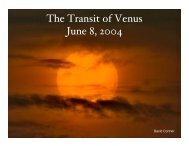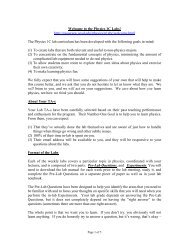Solar Ev. - CASS
Solar Ev. - CASS
Solar Ev. - CASS
You also want an ePaper? Increase the reach of your titles
YUMPU automatically turns print PDFs into web optimized ePapers that Google loves.
Star Birth
Star-Forming Clouds• Stars form in darkclouds of dusty gasin interstellar space• The gas between thestars is called theinterstellarmedium
Molecular Clouds• Most of the matter in star-forming clouds is in the formof molecules (H 2 , CO,…)• These molecular clouds have a temperature of 10-30 Kand a density of about 1000 molecules per cubic cm• Most of what we know about molecular clouds comesfrom observing the emission lines of carbon monoxide:CO (More about this later)
Observing Newborn Stars• Visible light from anewborn star isoften trapped withinthe dark, dusty gasclouds where thestar formed
Observing Newborn Stars• Observing theinfrared light from acloud can reveal thenewborn starembedded inside it
Gravity versus Pressure• Gravity can create stars only if it can overcome theforce of thermal pressure in a cloud• A typical molecular cloud (T~ 30 K, n ~ 300particles/cm 3 ) must contain at least a few hundredsolar masses for gravity to overcome pressure• Emission lines from molecules in a cloud can preventa pressure buildup by converting thermal energy intoinfrared and radio photons
Resistance to Gravity• A cloud must haveeven more mass tobegin contracting ifthere are additionalforces opposinggravity• Both magnetic fieldsand turbulent gasmotions increaseresistance to gravity
Fragmentation of a Cloud• Gravity within a contracting gas cloudbecomes stronger as the gas becomes denser• Gravity can therefore overcome pressure insmaller pieces of the cloud, causing it to breakapart into multiple fragments, each of whichmay go on to form a star
Fragmentation of a Cloud• This simulationbegins with aturbulent cloudcontaining 50 solarmasses of gas
Fragmentation of a Cloud• The random motionsof different sectionsof the cloud cause itto become lumpy
Fragmentation of a Cloud• Each lump of thecloud in whichgravity canovercome pressurecan go on to becomea star• A large cloud canmake a wholecluster of stars
Growth of a Protostar• Matter from thecloud continues tofall onto theprotostar until eitherthe protostar or aneighboring starblows thesurrounding gasaway
Conservation ofAngular Momentum• The rotation speedof the cloud fromwhich a star formsincreases as thecloud contracts
Rotation of acontractingcloud speedsup for thesame reason askater speedsup as she pullsin her arms
Flattening• Collisions betweenparticles in thecloud cause it toflatten into a disk
Formation of Jets• Rotation providesa preferentialdirection forexpulsion of highenergy gas causingjets of matter toshoot out along therotation axis
Jets & DisksJets areobservedcoming fromthe centers ofdisks aroundprotostars
From Protostar to Main Sequence• Protostar looks starlike after the surrounding gas isblown away, but its thermal energy comes fromgravitational contraction, not fusion• Contraction must continue until the core becomes hotenough for nuclear fusion• Contraction stops when the energy released by corefusion balances energy radiated from the surface—thestar is now a main-sequence star
Birth Stages on a Life Track• Life track illustrates star’s surfacetemperature and luminosity at differentmoments in time
Assembly of a Protostar• Luminosity and temperature grow asmatter collects into a protostar
1. Protostar: star is cool, embedded in molecular cloud;energy source is Gravity.
Convective Contraction• Surface temperature remains near 3,000 KGravity as energy source produces energythroughout protostar: convection is main energytransport mechanism
Radiative Contraction• Nuclear reactions “turn on”. Luminosity remainsnearly constant as contraction of core continues.Energy is from gravity and nuclear reactions,while radiation is transporting energy
Self-Sustaining Fusion• Core temperature continues to rise untilstar arrives on the main sequence
Life Tracks for Different Masses• Models show thatSun required about30 million years togo from protostar tomain sequence• Higher-mass starsform faster• Lower-mass starsform more slowly
Main Sequence H-burningA starremains onthe mainsequence aslong as it canfuse hydrogeninto helium inits core
Thought QuestionWhat happens when a star can no longer fusehydrogen to helium in its core?A. Core cools offB. Core shrinks and heats upC. Core expands and heats upD. Helium fusion immediately begins
Thought QuestionWhat happens when a star can no longer fusehydrogen to helium in its core?A. Core cools offB. Core shrinks and heats upC. Core expands and heats upD. Helium fusion immediately begins
Broken Thermostat• As the core contracts,H begins fusing to Hein a shell around thecore• Luminosity increasesbecause the corethermostat isbroken—the increasingfusion rate in the shelldoes not stop the corefrom contracting
Life Track after Main Sequence• Observations of starclusters show that astar becomes larger,redder, and moreluminous after itstime on the mainsequence is over
Helium Fusion - Triple Alpha ProcessHelium fusion does not begin right away because itrequires higher temperatures than hydrogen fusion—largercharge leads to greater repulsionFusion of two helium nuclei doesn’t work, so heliumfusion must combine three He nuclei to make carbon
Helium Flash• Thermostat is broken in low-mass red giantbecause degeneracy pressure supports core• Core temperature rises rapidly when helium fusionbegins• Helium fusion rate skyrockets until thermalpressure takes over and expands core again
Helium burning in core;H shell burningHelium burning stars neither shrink nor growbecause core thermostat is temporarily fixed.
Life Track after Helium Flash• Models show that ared giant shouldshrink and becomeless luminous afterhelium fusionbegins in the core
Double Shell Burning• After core helium fusion stops, He fuses intocarbon in a shell around the carbon core, and Hfuses to He in a shell around the helium layer• This double-shell burning stage never reachesequilibrium—fusion rate periodically spikesupward in a series of thermal pulses• With each spike, convection dredges carbon upfrom core and transports it to surface
End of Fusion• Fusion progresses no further in a low-mass starbecause the core temperature never grows hotenough for fusion of heavier elements (some Hefuses to C to make oxygen)• Degeneracy pressure supports the white dwarfagainst gravity
Planetary Nebulae• Double-shell burning ends with a pulsethat ejects the H and He into space as aplanetary nebulaRing Nebula in Lyra• The core left behind becomes a whitedwarf
Life Stages: 1M sun StarThe evolution ofthe Sun is typicalof Low Mass Stars0.08 < M < 8M sun
Life Track of a Sun-Like Star
Earth’s Fate• Sun’s radius will grow to near currentradius of Earth’s orbit
Earth’s Fate• Sun’s luminosity will rise to 1,000 timesits current level—too hot for life on Earth
Life Stages1. Protostar: gravitational contraction2. Onset of Nuclear Reactions: gravity plus nukes3. Main Sequence: 1 H --> 4 He fusion (p-p chain) in core4. End of M/S - 10 billion yrs5. Red Giant: 1 H --> 4 He fusion in shell around contracting core(leading to He Flash)6. He Main Sequence: He fusion in core (horizontal branch)7. Double-shell ( 4 He --> 12 C; 1 H --> 4 He) burning (red giant)8. Ejection of H and He in a Planetary Nebula reveals hot(100,000K) stellar core9. Leaving behind an inert White Dwarf (radiates store ofthermal energy)
What is the smallest mass anewborn star can have?
Fusion and Contraction• Fusion will not begin in a contracting cloud if somesort of force stops contraction before the coretemperature rises above 10 7 K.• Thermal pressure cannot stop contraction because thestar is constantly losing thermal energy from itssurface through radiation• Is there another form of pressure that can stopcontraction?
Degeneracy Pressure:Laws of quantum mechanics prohibit two electronsfrom occupying same state in same place
Thermal Pressure:Depends on heat contentThe main form of pressurein most starsDegeneracy Pressure:Particles can’t be in samestate in same placeDoesn’t depend on heatcontent
Brown Dwarfs• Degeneracy pressurehalts the contractionof objects with
Brown Dwarfs• A brown dwarfemits infrared lightbecause of heat leftover fromcontraction• Its luminositygradually declineswith time as it losesthermal energy
Brown Dwarfs in Orion• Infraredobservations canreveal recentlyformed browndwarfs because theyare still relativelywarm and luminous
What is the greatest mass anewborn star can have?
Radiation Pressure• Photons exert aslight amount ofpressure when theystrike matter• Very massive starsare so luminous thatthe collectivepressure of photonsdrives their matterinto space
Upper Limit on a Star’s Mass• Models of starssuggest thatradiation pressurelimits how massivea star can be withoutblowing itself apart• Observations havenot found stars moremassive than about150M Sun
LuminosityTemperatureStars moremassivethan150M Sunwould blowapartStars lessmassivethan0.08M Suncan’tsustainfusion
What are the typical masses ofnewborn stars?
Demographics of Stars• Observations of star clusters show that star formationmakes many more low-mass stars than high-mass stars





